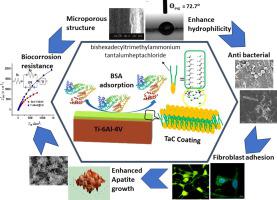当前位置:
X-MOL 学术
›
J. Ind. Eng. Chem.
›
论文详情
Our official English website, www.x-mol.net, welcomes your
feedback! (Note: you will need to create a separate account there.)
Micro structured Ti- scaffold decorated with Tantalum based amphiphilic assembly for improved biocompatibility, corrosion resistance and bactericidal characteristics
Journal of Industrial and Engineering Chemistry ( IF 5.9 ) Pub Date : 2024-01-03 , DOI: 10.1016/j.jiec.2024.01.003
Harshal Mehta , Pooja Devi , Gurpreet Kaur , Ganga Ram Chaudhary , Nirmal Prabhakar , Nitin Kumar Singhal
Journal of Industrial and Engineering Chemistry ( IF 5.9 ) Pub Date : 2024-01-03 , DOI: 10.1016/j.jiec.2024.01.003
Harshal Mehta , Pooja Devi , Gurpreet Kaur , Ganga Ram Chaudhary , Nirmal Prabhakar , Nitin Kumar Singhal

|
Fouling of body implants is inevitable as they stay in contact with body fluid of harsh ionic composition with varying pH, mixed with serum proteins and bacteria. Some alloys used as implant material comes with inherent bacterial resistant character or in other case the use of antibacterial coating is a popular measure to check the biofouling of their surfaces. But the development of bacterial resistant coating which don’t compromise the cytocompatibility of implant is still a challenging task. In this research, a novel antibacterial metallosurfactant bishexadecyltrimethylammoniumtantalum heptachloride (TaC) is synthesized to coat Ti-6Al-4V surface which provides excellent replacement to pure Tantalum which is a highly demanded implant material. For this, Ti-6Al-4V surface was acid treated to grow microstructures and porosity to help covalent bonding with TaC molecules and get durable and robust coating. The TaC coating was characterized as highly stable, hydrophilic, bioactive (assist osseointegration), antimicrobial against Gram negative () and Gram positive ( anti- corrosive in abiotic as well as biotic medium and compatible with fibroblast tissues. Being amphiphilic in nature, the coating interferes with serum albumin (BSA) adsorption on Ti-6Al-4V surface. Retardation in BSA adsorption due to TaC coating is evident from contact angle, XPS and electro chemical studies. The key appeal of coating is its simple fabrication technique and cost-effectiveness, moreover its chemical and structural features is such that it promotes fibroblast adhesion and viability. The coating exhibited a perfect balance to cater the antibiofouling activity and fibroblast proliferation which is biggest challenge in fabrication of biomaterials. Various results obtained from this comprehensive study may advocate the clinical applications of Ta metallosurfactant coating on biomedical alloys.
中文翻译:

微结构钛支架装饰有钽基两亲组件,可改善生物相容性、耐腐蚀性和杀菌特性
身体植入物的污染是不可避免的,因为它们与具有不同 pH 值的恶劣离子成分的体液接触,并与血清蛋白和细菌混合。一些用作植入材料的合金具有固有的抗菌特性,或者在其他情况下,使用抗菌涂层是检查其表面生物污垢的常用措施。但开发不损害植入物细胞相容性的抗菌涂层仍然是一项具有挑战性的任务。在这项研究中,合成了一种新型抗菌金属表面活性剂双十六烷基三甲基七氯化钽铵(TaC)来涂覆Ti-6Al-4V表面,为高需求的植入材料纯钽提供了良好的替代品。为此,Ti-6Al-4V 表面经过酸处理,以生长微结构和孔隙率,以帮助与 TaC 分子共价键合,并获得耐用且坚固的涂层。 TaC 涂层具有高度稳定性、亲水性、生物活性(协助骨整合)、抗革兰氏阴性菌和革兰氏阳性菌(在非生物和生物介质中具有防腐作用,并与成纤维细胞组织相容)的特点。涂层本质上是两亲性的,因此干扰 Ti-6Al-4V 表面上的血清白蛋白 (BSA) 吸附 从接触角、XPS 和电化学研究中可以明显看出,TaC 涂层对 BSA 吸附的延迟是其简单的制造技术和成本效益。此外,其化学和结构特征可促进成纤维细胞粘附和活力,该涂层表现出完美的平衡,以满足生物材料制造中最大的挑战——抗生物污染活性和成纤维细胞增殖。 这项综合研究获得的各种结果可能会促进Ta金属表面活性剂涂层在生物医用合金上的临床应用。
更新日期:2024-01-03
中文翻译:

微结构钛支架装饰有钽基两亲组件,可改善生物相容性、耐腐蚀性和杀菌特性
身体植入物的污染是不可避免的,因为它们与具有不同 pH 值的恶劣离子成分的体液接触,并与血清蛋白和细菌混合。一些用作植入材料的合金具有固有的抗菌特性,或者在其他情况下,使用抗菌涂层是检查其表面生物污垢的常用措施。但开发不损害植入物细胞相容性的抗菌涂层仍然是一项具有挑战性的任务。在这项研究中,合成了一种新型抗菌金属表面活性剂双十六烷基三甲基七氯化钽铵(TaC)来涂覆Ti-6Al-4V表面,为高需求的植入材料纯钽提供了良好的替代品。为此,Ti-6Al-4V 表面经过酸处理,以生长微结构和孔隙率,以帮助与 TaC 分子共价键合,并获得耐用且坚固的涂层。 TaC 涂层具有高度稳定性、亲水性、生物活性(协助骨整合)、抗革兰氏阴性菌和革兰氏阳性菌(在非生物和生物介质中具有防腐作用,并与成纤维细胞组织相容)的特点。涂层本质上是两亲性的,因此干扰 Ti-6Al-4V 表面上的血清白蛋白 (BSA) 吸附 从接触角、XPS 和电化学研究中可以明显看出,TaC 涂层对 BSA 吸附的延迟是其简单的制造技术和成本效益。此外,其化学和结构特征可促进成纤维细胞粘附和活力,该涂层表现出完美的平衡,以满足生物材料制造中最大的挑战——抗生物污染活性和成纤维细胞增殖。 这项综合研究获得的各种结果可能会促进Ta金属表面活性剂涂层在生物医用合金上的临床应用。































 京公网安备 11010802027423号
京公网安备 11010802027423号